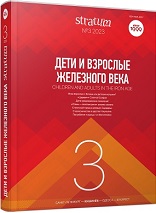Металлургический «завод» раннего железного века в Уральских горах
An Early Iron Age Metallurgical ”Plant” in the Ural Mountains
Author(s): Victor A. Borzunov, Galina V. Beltikova, Pavel A. Kosintsev, Sergei V. KuzminykhSubject(s): History, Archaeology
Published by: Издательский дом Stratum, Университет «Высшая антропологическая школа»
Keywords: Middle Trans-Urals; mountain-forest zone; Early Iron Age; a metallurgical center
Summary/Abstract: The authors describe the westernmost metallurgical center of the 5th—2nd centuries BC left by the aboriginal Itkul’ culture of the forest Trans-Urals in 8th/7th—3rd/2 nd centuries BC. It was founded in the upper reaches of the Ufa river, in Serny Klyuch tract, on top of a high (20—25 m) limestone rock with three steep edges, on the ruins of sites and settlements of the Eneolithic and Bronze Age. After the construction of the first copper-smelting complexes, the site of the settlement from the floor side was fenced with a log defensive wall with an external moat 40—42 m long. The ancient settlement is miniature, with an area of about 1,000 sq. m. Two excavations (502 sq. m) explored half of the site and 26 m of the fortification line. The remains of 19 adobe blast furnaces, three adobe platforms for metal processing, several pits and fireplaces for melting metal, three industrial and residential buildings of a frame-and-pillar structure were uncovered. In addition to the clan of metallurgists of the aboriginal Itkul’ culture, the population of the settlement included small groups of newcomers: initially, the descendants of the taiga communities of the Gamayun culture, who migrated from the north, from the upper reaches of the Iset’ river, later — the bearers of the Gorokhovo culture, who fled from the Tobol region and the lower reaches of the Iset’ river under the pressure of the warlike Sargat tribes, the ancient ancestors of the Hungarians who came from the east, from the Ishim-Irtysh forest-steppe. Traces of full cycle metallurgical production were revealed on the site — from copper smelting to casting and forging of finished products. The main part of non-ferrous metal produced by metallurgists of the mountain-forestry Trans-Urals was intended for export to neighboring and more distant territories. A blank of an iron knife-dagger found in one of the furnaces, and a series of Itkul’ iron products found in other places, confirm the hypothesis of the emergence of its own ferrous metallurgy in the forests of the Middle Urals around the 5th—4th centuries BC.
Journal: Stratum plus. Археология и культурная антропология
- Issue Year: 2023
- Issue No: 3
- Page Range: 201-242
- Page Count: 42
- Language: Russian
- Content File-PDF

